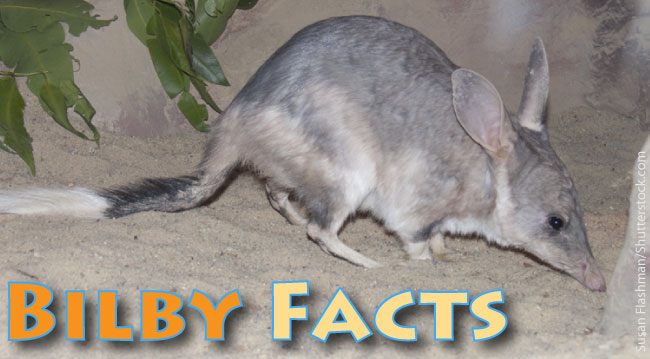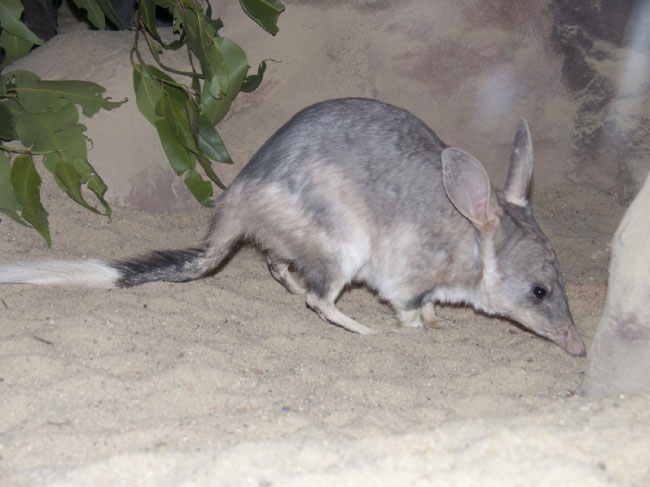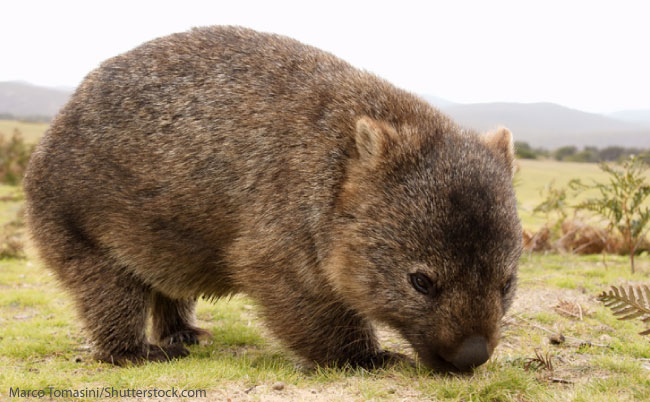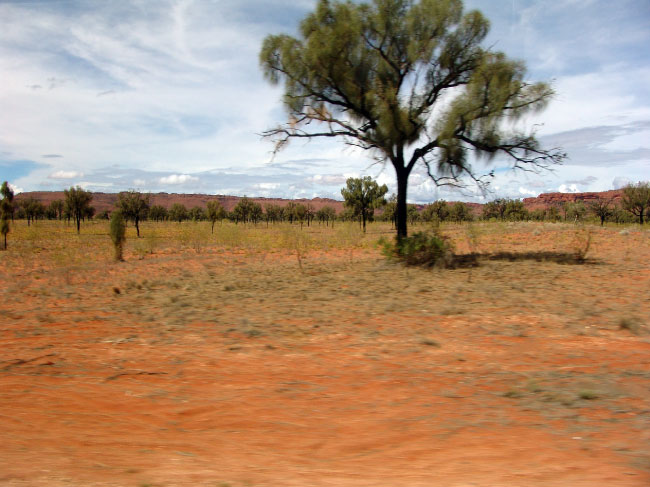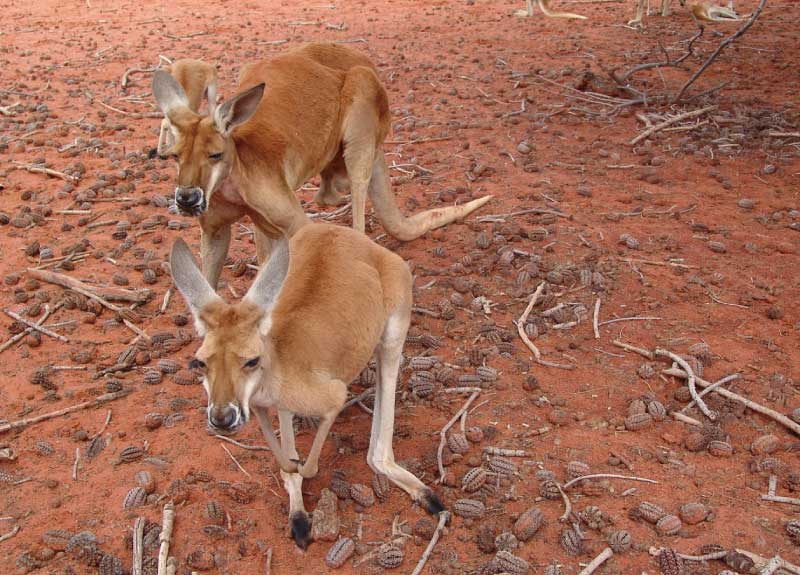The bilby is a rabbit-sized marsupial that lives in the arid, desert regions of Australia. Of the two species of bilby that lived in Australia at the turn of the nineteenth century, only the greater bilby survives. The greater bilby itself is rated ‘vulnerable’, and several projects are underway to protect this popular Australian animal. This article contains bilby facts for kids, and is part of the Active Wild Australian Animals series.
Be sure to watch the video to find out what the bilby looks like, and how it moves around.
Bilby Facts
Nowadays, the word ‘bilby’ is usually used to refer to the greater bilby. The lesser bilby became extinct in the 1950’s, and today the greater bilby is the only remaining species of bilby.
In this article, when we say ‘bilby’, we’ll be referring to the greater bilby.
Scientific Name, Family and Order
The scientific name for the greater bilby is Macrotis lagotis. It is a member of the Thylacomyidae family, and a member of the order Peramelemorphia.
Macrotis means ‘big-eared’ in Greek, and looking at a bilby the name is warranted, if a little mean!
Bilbys are also known as 'rabbit bandicoots' and 'dalgytes'. The word ‘bilby’ comes from an Aboriginal word used by the Yuwaalaraay people, and means ‘long nosed rat’.
Bilby Facts: Is a Bilby A Bandicoot?
Bilbies and bandicoots are in the same order, Peramelemorphia. The word ‘bandicoot’ is sometimes used to refer to bilbies and bandicoots, but strictly speaking bilbies are in a family of their own.
What Does A Bilby Look Like?
The Yuwaalaraay people weren’t too far off with their ‘long tailed rat’ description, although male bilbies are more rabbit-sized than rat-sized.
Bilbies have pointed heads which taper into a narrow snout. They have small black eyes, and of course, those big, prominent ears.
Bilbies don’t have very good eyesight, and rely on their hearing and sense of smell to find food and to sense danger.
Bilbies are nocturnal, only emerging from their burrows at night.
Their forelimbs are strong – designed for digging – and three of the five digits on each forepaw is clawed.
You can see what bilbies look like in the video below:
Male bilbies are almost twice the size of females, growing up to 55 cm (22 inches) in length. Bilbys have long tails, which add an additional 29cm (11.5 inches) to their length.
Bilbies weigh up to 2.5 kg (5.5 pounds), females weighing proportionally less.
The bilby’s coat is light grey on top, and a lighter grey-white on the undersides. Their tails start black or dark grey, and end with white tips.
Although they are marsupials, bilbies don’t jump like kangaroos. Instead, they move around with a hare-like movement.
Being marsupials, female bilbies have pouches, in which they carry their young. We’ll find out more about the bilby life-cycle further down the page, but one interesting fact about bilbies is that the pouch opens at the bottom, rather than the top.
It is thought that this has evolved to prevent dirt from entering the pouch when the bilby is burrowing. Wombats also have reversed pouches.
Bilby Habitat
Bilbies live in arid (dry), desert regions of Australia. Today, they are mainly found in central and northern regions, including the Tanami Desert (Northern Territory), the Gibson Desert and Great Sandy Desert (Western Australia). A separate population lives in southwest Queensland.
There are also reintroduced populations in several national parks and sanctuaries around Australia.
Helped By Fire?
The bilby has been found to benefit from bush fires that naturally sweep through their habitat from time to time. They eat fast-growing plants that grow after a fire has passed. Bilbies may also be able to shelter from bush fires in their burrows.
Bilbys are burrowing creatures, and as we’ve seen have strong legs and claws for digging. They make several burrows (up to 12) within their range.
Bilby burrows have a single entrance, and are around 2-3 metres long. Only one bilby lives in a burrow.
Bilby burrows have been found to be beneficial to the ecosystem, by providing shelter for other species, and potentially improving plant diversity by providing areas with a different temperature and humidity for seeds.
Male bilbies can cover up to 5km in search of food. The range of a female bilby is smaller, around 1.5 km.
Bilbies are solitary animals, usually only coming together when the male seeks out potential mates.
Bilby Life-Cycle
After mating, the male bilby pays no part in the raising of the young.
Gestation (how long a female is pregnant) is remarkably short in bilbies: only lasting 12 to fourteen days. This is one of the shortest gestation times of all mammals.
Baby bilbies are called joeys – just like kangaroo babies.
After being born, the joeys crawl into the female bilby’s pouch. At this stage they are extremely undeveloped. They spend another 10 to 11 weeks in the mother’s pouch, feeding on milk until they are ready to emerge. The joeys will then spend a few more weeks in the burrow before becoming fully independent.
Female bilbies usually give birth to 2-3 joeys at a time, and can have up to 4 litters in a year.
What Do Bilbies Eat?
Bilbies are omnivores, which means they eat a mixture of animals and plants. They have a varied diet, which includes: insects such as termites, spiders, other small animals such as lizards and worms, small mammals, fruit, bulbs, and seeds.
Bilbies find their food by searching in the sand with their long snouts. They don’t need to drink, as they get all of the water they need from their food.
Are Bilbies Endangered?
The bilby’s natural predators include eagles, snakes and lizards. However, bilbies are far more threatened by introduced species such as feral cats and foxes.
Bilby populations are strongest where there are fewer foxes and livestock.
Another problem for the bilby is the spread of the rabbit, as both species compete for the same food.
Loss of habitat due to farming and mining is a major concern.
Bilbies used to be found in over 70% of mainland Australia. It is thought that today there may be fewer than 10,000 bilbies left in the wild, and that number is decreasing.
Bilbies are currently rated ‘vulnerable’ on the IUCN Red List.
Several re-introduction projects are currently underway. Other ideas to raise awareness of the bilby’s vulnerable status include using ‘Easter Bilbies’ rather than ‘Easter Bunnies’ to celebrate Easter.
Several organisations have been formed to help bilbies and other Australian species. Take a look at the Save The Bilby Fund website, and see what you can do to help!
Bilby Facts
- The bilby is a rabbit-sized marsupial.
- The bilby is nocturnal – active only at night.
- Male bilbies are almost twice the size of female bilbies.
- Bilbies have poor eyesight, and rely on their acute hearing and sense of smell.
- A female bilby’s pouch opens downwards to prevent earth from entering while digging.
- Baby bilbies are called joeys.
- Bilbies are currently rated ‘Vulnerable’ on the IUCN Red List
- It is thought that there may be fewer than 10,000 bilbies left in the wild, and this number is decreasing.
- The spread of the rabbit, and other non-native species such as the fox, are affecting bilby numbers.
- Chocolate ‘Easter Bilbies’ are eaten at Easter, as a way of raising awareness of the bilby’s vulnerable status.
- Each year, National Bilby Day is held on the second Sunday in September.
Bilby Facts Conclusion
We hope that you have enjoyed learning about this cute marsupial. Be sure to tell your friends about the bilby, and the problems that the species is facing. The more people know about bilbies, the more likely it is that something will be done to help them. Why not get in touch with a bilby conservation society to see what you can do to help?
You can read about more awesome Australian animals here: Australian Animals Master Page.

